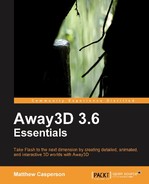Although it is quite often and more convenient to embed resources into the SWF file, there are times when this is not desirable. Away3D includes a number of classes to aid in loading external resources.
There are some considerations to be aware of when accessing external resources. One of the issues is that the loading process is asynchronous, which means that the actual process of downloading an external resource is done in the background. Normally, you would deal with the data once it has been retrieved by way of a call-back function, which is called when the Event.COMPLETE event is dispatched.
For a simple bitmap material, the BitmapFileMaterial class deals with this background loading for you. You supply the URL of the external texture image, and the BitmapFileMaterial class takes care of all the asynchronous loading process.
Other material types don't have an equivalent of the BitmapFileMaterial to handle loading of external textures. For this Away3D supplies the TextureLoadQueue class, which will load a number of external resources as a group and notify you when they are all ready.
As you can see, the BitmapFileMaterial is very straightforward to use. By hiding the details of the asynchronous loading process, the BitmapFileMaterial class allows us to simply apply it like any other material. All we need to do is supply the location of the texture file to load.
protected function applyBitmapFileMaterial():void
{
initSphere();
materialText.text = "BitmapFileMaterial";
var newMaterial:BitmapFileMaterial =
new BitmapFileMaterial("earth_diffuse.jpg");
currentPrimitive.material = newMaterial;
}The BitmapFileMaterial class extends the BitmapMaterial class, which means the init object parameters listed for the BitmapMaterial class also apply to the BitmapFileMaterial class.
The process becomes a little more complicated when you need to load several textures to create one material. Take the Dot3BitmapMaterial class as an example. It requires both diffuse texture and normal map.
The TextureLoadQueue can be used to load multiple external resources as a group. This allows us to initiate the loading of all the textures required by a class like Dot3BitmapMaterial, and then create a new instance of the class when all are loaded.
protected function applyExternalDot3BitmapMaterial():void
{
initSphere();
initDirectionalLight();
materialText.text = "External Dot3BitmapMaterial"; First, we create a new instance of the TextureLoadQueue class.
var textureLoadQueue:TextureLoadQueue =
new TextureLoadQueue(); We then need to create two additional objects for each file to be loaded. The first is a URLRequest object, whose constructor takes the URL of the external file as the first parameter.
var req:URLRequest =
new URLRequest("earth_diffuse.jpg"); The second is a TextureLoader object.
var loader:TextureLoader = new TextureLoader();
We then pass both of these objects to the TextureLoadQueue addItem() function.
textureLoadQueue.addItem(loader, req);
This process is repeated for the normal map texture file.
req = new URLRequest("earth_normal.jpg")
loader = new TextureLoader();
textureLoadQueue.addItem(loader, req); The Event.COMPLETE event will be dispatched by the TextureLoaderQueue object once all of the external files have been loaded. Once this event has been dispatched, we can get access to the bitmap data required to create the material. For convenience, we will create an anonymous function to respond to this event.
textureLoadQueue.addEventListener(
Event.COMPLETE,
function(event:Event):void
{ We create two BitmapData variables, which will be assigned to the data contained in the two external files we have just loaded.
var diffuse:BitmapData;
var normal:BitmapData;Unfortunately, the TextureLoaderQueue does not index the loaded images in a way that is easy to access. Instead, it provides an array of TextureLoader objects, and each individual TextureLoader object can then be identified and then processed. This involves iterating over the whole array to find out which TextureLoader objects relate to which external files.
for each (var image:TextureLoader in textureLoadQueue.images)
{ Regardless of which external file the current TextureLoader object obtained its data from, we first create a new BitmapData object and draw the contents of the TextureLoader into it.
var bitmapData:BitmapData =
new BitmapData(image.width, image.height);
bitmapData.draw(image); Using the filename property of the current TextureLoader object, we can work out which external file it obtained its data from. This allows us to reference the new BitmapData object we just created with either the diffuse or normal variable.
if (image.filename == "earth_diffuse.jpg")
diffuse = bitmapData;
else if (image.filename == "earth_normal.jpg")
normal = bitmapData;
}Now that we have a reference to the diffuse and normal-map bitmaps, we can go ahead and create the Dot3BitmapMaterial object.
currentPrimitive.material =
new Dot3BitmapMaterial(diffuse, normal);
}
); Finally, with the anonymous call back function in place we can now request that the TextureLoaderQueue start loading the files by calling its start() function.
textureLoadQueue.start();
}
}
}